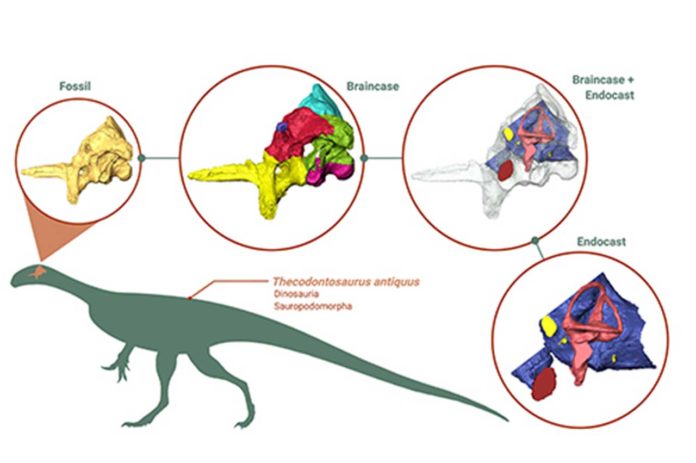Using advanced imaging and 3-D modeling techniques, scientists at the University of Bristol have rebuilt the brain of a Bristol dinosaur named Thecodontosaurus and gain insights into its food and agility.
This analysis of Thecodontosaurus revealed many exciting features that are quite surprising. Scientists found that the Thecodontosaurus may have eaten meat, unlike its giant long-necked later relatives, including Diplodocus and Brontosaurus, which only fed on plants. And unlike its last relatives, which roams around on all four legs, the Thecodontosaurus have walked on two legs and been occasionally carnivorous.
Thecodontosaurus lived in the Late Triassic age some 205 million years ago and was the size of a large dog. The fossils of Thecodontosaurus were originally discovered in the 1800s and well preserved at the University of Bristol.
By generating a 3D model from CT scans by digitally extracting the bone from the rock, scientists identified its anatomical details of the brain and inner ear previously unseen in the fossil.
Antonio Ballell, the lead author of the study published today in the Zoological Journal of the Linnean Society, said, “Even though the actual brain is long gone, the software allows us to recreate brain and inner ear shape via the dimensions of the cavities left behind. The braincase of Thecodontosaurus is beautifully preserved, so we compared it to other dinosaurs, identifying common features and some that are specific to Thecodontosaurus.”
“Its brain cast even showed the detail of the floccular lobes, located at the back of the brain, which is important for balance. Their large size indicates it was bipedal. This structure is also associated with the control of balance and eye and neck movements, suggesting Thecodontosaurus was relatively agile and could keep a stable gaze while moving fast.”
“Our analysis showed parts of the brain associated with keeping the head stable, and eyes and gaze steady during movement were well-developed. This could also mean Thecodontosaurus could occasionally catch prey, although its tooth morphology suggests plants were the main component of its diet. It’s possible it adopted omnivorous habits.”
Scientists also reconstructed it’s inner ears to estimate its hearing ability than other dinosaurs. They found that the Thecodontosaurus has a relatively high hearing frequency, pointing towards some social complexity – an ability to recognize various squeaks and honks from different animals.
Professor Mike Benton, the study co-author, said: “It’s great to see how new technologies are allowing us to find out even more about how this little dinosaur lived more than 200 million years ago.”
“We began working on Thecodontosaurus in 1990, and it is the emblem of the Bristol Dinosaur Project, an educational outreach scheme where students go to speak about science in local schools. We’re very fortunate to have so many well-preserved fossils of such an important dinosaur here in Bristol. This has helped us understand many aspects of the biology of Thecodontosaurus, but there are still many questions about this species yet to be explored.”
The Natural Environment Research Council (NERC), the Leverhulme Trust, and the Royal Society funded this study.
Journal Reference:
- Antonio Ballell, J Logan King, James M Neenan, Emily J Rayfield, Michael J Benton, The braincase, brain, and palaeobiology of the basal sauropodomorph dinosaur Thecodontosaurus antiquus, Zoological Journal of the Linnean Society, zlaa157, DOI: 10.1093/zoolinnean/zlaa157
